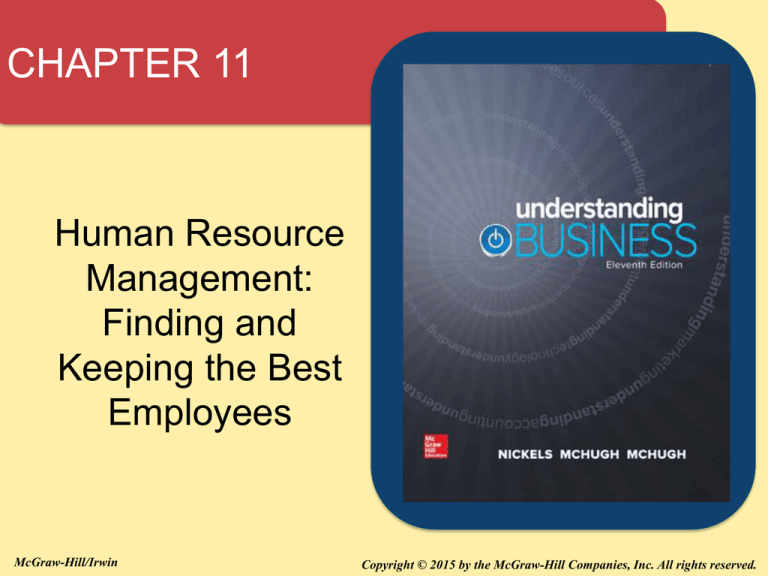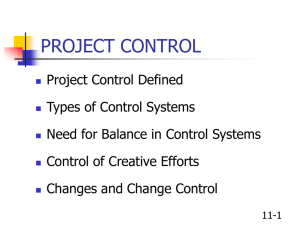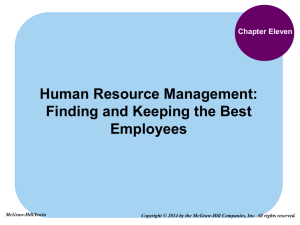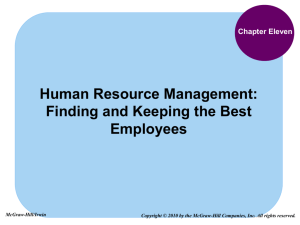
CHAPTER 11
Human Resource
Management:
Finding and
Keeping the Best
Employees
McGraw-Hill/Irwin
Copyright © 2015 by the McGraw-Hill Companies, Inc. All rights reserved.
What is HRM?
• Human Resource Management (HRM)
• All the activities involved in acquiring, developing and
maintaining an organization’s human resources
• HRM Activities
• Acquiring Human Resources
–Planning labor needs
–Job Analysis
–Recruiting
–Selection
• Developing Human Resources
–Orientation
–Training and Development
–Evaluation (Performance Appraisals)
• Maintaining Human Resources
–Financial Compensation
–Benefits
• Legal Issues Impacting HRM
11-2
HUMAN RESOURCE
MANAGEMENT
LO 11-1
• Human Resource Management (HRM) -- The
process of determining human resource needs and
then recruiting, selecting, developing, motivating,
evaluating, compensating and scheduling employees
to achieve organizational goals.
• HRM’s role has grown because of:
1. Increased recognition of employees as a
resource.
2. Changes in law that rewrote old workplace
practices.
11-3
HUMAN RESOURCE MANAGEMENT
LO 11-1
11-4
UNCOVERING the
SECRETS of HRM
LO 11-1
Things Your HR Manager Doesn’t Tell You
• We’re short-staffed and under pressure too.
• We’re not always going to be able to help in the
way you hope.
• We can help you move up the career ladder.
• What you post on Facebook can get you fired.
Source: Smart Money, www.smartmoney.com, accessed November 2014.
11-5
HUMAN RESOURCE PLANNING
LO 11-3
HRM Planning
•
Determining the optimal number of employees
•
Clearly identifying job positions and their
requirements
Workforce Profile:
Personnel inventory
-
Age
Education
Training
Experience
Specialized
skills
- Current position
- Previous
positions
Forecasting
Based on
-
Predicted sales
Current workforce skills
Technology changes
Use of temporary
workers
- Turnover
- Retirement
- Planned reassignments
11-6
HUMAN RESOURCE PLANNING
LO 11-3
Demand > Supply
Hire – Bring in new employees
Promote – Put existing employees in new, “better” positions
Transfer – Moving an existing employee to a different position
Supply > Demand
Laid Off – termination for economic or business reason
Fire – terminating the employee for performance reasons
Attrition – normal reduction of the work force that occurs when
employees leave the firm on their own accord
(retire, find another job)
Early Retirement – letting employees within a few years of retirement
retire early and allowing them to receive their full benefits
11-7
WHAT’S a JOB ANALYSIS?
LO 11-3
Job Analysis – A study of what
employees do who hold various job
titles.
Two Parts of a Job Analysis:
•Job Description – A summary of the
objectives of the job, the type of work,
the responsibilities and duties, working
conditions and relationship to other
jobs.
•Job Specifications -- A summary of
the minimum qualifications needed to
do a particular job.
11-8
RECRUITING EMPLOYEES
LO 11-4
• Recruitment -- The set of activities for obtaining the
right number of qualified people at the right time.
• Human resource managers use both internal and
external sources to recruit employees.
• Small businesses often make use of web
sources like CareerBuilder and Monster to
recruit employees.
11-9
EMPLOYEE SOURCES
LO 11-4
11-10
SELECTION (i.e. HIRING) – MAKING
THE RIGHT CHOICE
LO 11-5
• Selection -- The process of
gathering information and
deciding who should be hired,
under legal guidelines, to
serve the best interest of the
individual and the
organization.
11-11
STEPS in the
SELECTION PROCESS
LO 11-5
1. Obtaining complete application forms
2. Conducting initial and follow-up interviews
3. Giving employment tests
4. Conducting background investigations
5. Obtaining results from physical exams
6. Establishing trial (probationary) work periods
11-12
OOPS!
LO 11-5
Areas Where Job Applicants Make Mistakes
Source: USA Today.
11-13
KEEPING the RIGHT FACE
on FACEBOOK
• Your online personality be appealing to
employers.
• Some of the worst things to do are:
- Posting provocative or inappropriate photos.
- Information on drug use or excessive drinking.
- Bad mouthing a previous employer.
- Discriminatory comments related to race, gender,
religion, etc.
11-14
HIRING CONTINGENT WORKERS
LO 11-5
• Contingent Workers -- Include part-time and
temporary workers, seasonal workers, independent
contractors, interns and co-op students.
• There are about 5.7
million contingent
workers in the U.S.
• Majority of contingent
workers are under 25.
11-15
WHY HIRE
CONTINGENT WORKERS?
LO 11-5
• Companies hire contingent workers:
- When full-time workers are on leave.
- During periods of peak demand.
- In uncertain economic times.
- To save on employee benefits.
- To screen candidates for future employment.
11-16
ORIENTATION
Effective orientations are the first
step in the training & development
process
Introduce employees to the
company culture
Strong orientation programs reduce
employee turnover
Formal or Informal, Long or Short
LO 11-6
11-17
TRAINING and DEVELOPING
EMPLOYEES
LO 11-6
• Training and Development -- All
attempts to improve productivity by
increasing an employee’s ability to
perform.
• Training focuses on TEACHING
short-term skills.
• Development focuses on
ENHANCING long-term abilities.
11-18
MOST COMMONLY USED TRAINING
and DEVELOPMENT ACTIVITIES
•
•
LO 11-6
Training
– The process of teaching employees new
skills
– Training Programs
• On-the-job training
• Job simulation
• Off-the-job training
• Role Playing
• Classroom teaching and lectures
Developing Labor
– The process of enhancing or augmenting
employees’ current skills
– Development Programs
• Conferences / Seminars
• Classroom teaching and lectures
• Role Playing
11-19
WHY GOOD EMPLOYEES QUIT
Source: Robert Half International
LO 11-6
11-20
USING NETWORKS and
MENTORING
LO 11-6
• Networking -- Establishing and maintaining contacts
with key managers in and out of the organization and
using those contacts to develop relationships.
• Mentors -- Managers who supervise, coach and
guide selected lower-level employees by acting as
corporate sponsors.
• Networking and mentoring go beyond the work
environment.
11-21
APPRAISING PERFORMANCE
on the JOB
LO 11-7
Performance Appraisal -- An evaluation that measures employee
performance against established standards in order to make decisions
about promotions, compensation, training or termination.
Major Uses of a Performance Appraisal
•Identify training needs
•Use as a promotion tool
•Recognize worker’s achievements
•Evaluate the firm’s hiring process
•Judge the effectiveness of the firm’s
orientation process
•Use as a basis for possible termination of
a worker
11-22
SIX STEPS of PERFORMANCE
APPRAISALS
LO 11-7
1. Establishing performance standards that are
understandable, measurable and reasonable.
2. Clearly communicating those standards.
3. Evaluating performance against the standards.
4. Discussing the results with employees.
5. Taking corrective action.
6. Using the results to make decisions.
11-23
DOs and DON’Ts of
PERFORMANCE APPRAISALS
LO 11-7
11-24
PERFORMANCE APPRAISAL
MISTAKES
LO 11-7
Common Problems Made While Reviewing Employees
• Contrast Effect - Comparing one employee to
another.
• Halo/Horn Effect - Allowing performances in specific
areas to unfairly influence overall performance
evaluation.
• Similar-to-Me Effect - Generosity to those you feel
are more like you.
11-25
COMPENSATION PROGRAMS
LO 11-8
2 Basic Ways to Compensate Employees
1.
2.
Financial Compensation
• The payment employees receive in return for their labor
Benefits
• Rewards in addition to regular compensation that are provided
indirectly to the employee
Effective employee reward systems must:
•Enable employees to satisfy their basic needs
•Provide rewards comparable to those offered
by other firms
•Be distributed fairly in the organization
•Recognize that different people have different needs
11-26
TYPES of PAY SYSTEMS
LO 11-8
11-27
TYPES of PAY SYSTEMS
LO 11-8
11-28
TYPES of PAY SYSTEMS
LO 11-8
11-29
FRINGE BENEFITS on the JOB
LO 11-8
• Fringe Benefits -- Sick leave, vacation
pay, pension and health plans that
provide additional compensation to
employees beyond base wages.
• In 1929, fringe benefits accounted for
less than 2% of payroll cost. Today it’s
about 30%.
• Healthcare has been the most
significant increase in fringe benefit
cost.
11-30
EMPLOYEE BENEFITS: FROM
BIRTHDAY CAKES TO DEATH
BENEFITS
Optional Benefits
Legally Mandated Benefits
•
•
•
•
•
Social Security
Medicare Contributions
Unemployment Payments
Workers’ Compensation
Federal Family and Medical
Leave
Source: Kiplinger’s Personal Finance, November 2010.
LO 11-8
•
•
•
•
•
•
Paid Vacation & Holidays
Paid Sick Days
Health Insurance
Retirement Programs (401k)
Product Discounts
Tuition Reimbursement
11-31
The RANGE of
FRINGE BENEFITS
LO 11-8
• Fringe benefits include incentives like:
- Company cars
- Country club memberships
- Recreation facilities
- Special home mortgage rates
- Paid and unpaid sabbaticals
- Day-care and elder care services
- Dental and eye care
- Legal counseling
- Short or compressed work weeks
11-32
CAFETERIA-STYLE and
SOFT BENEFITS
LO 11-8
• Cafeteria-Style Fringe Benefits -- Allow
employees to choose the benefits they want (up to a
certain dollar amount).
• Soft Benefits include:
- Onsite haircuts and shoe repair
- Concierge services
- Free meals at work
- Doggie daycare
- Onsite farmer’s markets
11-33
FLEXIBLE SCHEDULING PLANS
LO 11-9
• Flextime Plan -- Gives employees some freedom to choose
which hours to work as long as they work the required number of
hours or complete their tasks.
• Compressed Work Week -- Employees work the full number of
work hours, but in fewer than the standard number of days.
• Job Sharing -- Lets two or more part-time employees share on a
full-time job.
• Home Based Work – Allows employees to perform job by
telecommuting from offsite (or home) location
11-34
HOME-BASED WORK
LO 11-9
11-35
LEGAL ISSUES IMPACTING HRM
•
Civil Rights Act (1964, 1991), Title •
VII
–
–
–
–
–
–
–
Prohibits discrimination based on sex,
race, color, religion, or national origin
Enforced by EEOC (Equal Employment
Opportunity Commission), 1972
Disparate Treatment – intentional
discrimination
Disparate Impact – unintentional
discrimination
Affirmative Action – plan that increases
minorities and women in workforce
Reverse Discrimination
Sexual Harassment
• Quid Pro Quo
• Hostile Work Environment
•
Age Discrimination Act (1967)
–
–
Prevents discrimination against qualified
individuals with disabilities, and requires
employers to make reasonable
accommodations
AIDS
Fair Labor Standards Act (1938)
–
–
•
Prevents discrimination against individuals
aged 40 or above
Americans with Disabilities Act (1990)
–
•
LO 11-2
Establishes a minimum wage and overtime for
employees working over 40 hours per week
Most managers and other professionals are
exempt
Unemployment Compensation
(1930’s)
–
–
Requires employers to maintain insurance to
protect workers when laid off
20 weeks in SC (most other states: 26 weeks)
11-36
CIVIL RIGHTS ACT of 1964
LO 11-2
• Title VII prohibits discrimination in hiring, firing,
compensation, apprenticeships, training, terms,
conditions or privileges of employment based on:
- Race
- Religion
- Creed
- Sex
- National Origin
11-37
1972 EQUAL EMPLOYMENT
OPPORTUNITY ACT (EEOA)
LO 11-2
• Strengthened the Equal Employment Opportunity
Commission (EEOC).
• Gave EEOC the right to issue workplace
guidelines for acceptable employer conduct.
• EEOC could mandate specific recordkeeping
procedures.
• EEOC was vested with the power of enforcement.
11-38
CONTROVERSIAL PROCEDURES
of the EEOC
LO 11-2
• Affirmative Action -- Policy designed to “right past
wrongs” by increasing opportunities for minorities and
women.
• Reverse Discrimination -- Discriminating against
members of a dominant or majority group (e.g. whites
or males) usually as a result of policies designed to
correct previous discrimination against minority or
disadvantaged groups.
• This policy has been at the center of many
debates and lawsuits.
11-39
UNDERSTANDING AFFIRMATIVE
ACTION
LO 11-2
Affirmative Action (a series of executive orders)
– Applies to all employers with 50 or more employees holding
federal contracts in excess of $50,000
– Such employers must actively encourage job applications
from members of minority groups and hire qualified
employees from minority groups not fully represented in the
organization
•Valid Affirmative Action Program
1. Identify racial/gender imbalance
2. Plan doesn’t unnecessarily trammel rights of majority
3. No bar is created (no quotas)
4. Must be temporary
11-40
CIVIL RIGHTS ACT of 1991
and OFCCP
LO 11-2
• Civil Rights Act of 1991
- Amended Title VII and gave victims of
discrimination the right to a jury trial and possible
damages.
• Office of Federal Contract Compliance Programs
(OFCCP)
- Ensures that employers doing business with the
federal government comply with the
nondiscrimination and affirmative action laws.
11-41
LAWS PROTECTING
EMPLOYEES with DISABILITIES
LO 11-2
• Americans with Disabilities Act of 1990 (ADA)
- Requires employers to give applicants with physical or
mental disabilities the same consideration for employment as
people without disabilities.
- Passage in 2008 of Americans with
Disabilities Amendments Act
expanded protection.
- 2011 saw regulations that widen the
range of disabilities covered by the
ADA and shift the burden of proof of
disability from employees to
employers.
11-42
AGE DISCRIMINATION in
EMPLOYMENT ACT (ADEA)
LO 11-2
• Age Discrimination in Employment Act (ADEA)
- Protects workers 40 and
over from employment
and workplace
discrimination in hiring,
firing, promotion, layoff,
compensation, benefits,
job assignments and
training.
11-43
MINDING the LAW in HRM
LO 11-2
• Employers must know the law
and act accordingly.
• Legislation affects all areas of
HRM.
• Court cases highlight that
sometimes it’s proper to go
beyond providing equal rights.
• Changes in law and legislation
occur regularly.
11-44









